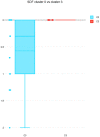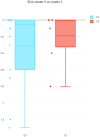Clustering for Automated Exploratory Pattern Discovery in Animal Behavioral Data
- PMID: 35812846
- PMCID: PMC9260587
- DOI: 10.3389/fvets.2022.884437
Clustering for Automated Exploratory Pattern Discovery in Animal Behavioral Data
Abstract
Traditional methods of data analysis in animal behavior research are usually based on measuring behavior by manually coding a set of chosen behavioral parameters, which is naturally prone to human bias and error, and is also a tedious labor-intensive task. Machine learning techniques are increasingly applied to support researchers in this field, mostly in a supervised manner: for tracking animals, detecting land marks or recognizing actions. Unsupervised methods are increasingly used, but are under-explored in the context of behavior studies and applied contexts such as behavioral testing of dogs. This study explores the potential of unsupervised approaches such as clustering for the automated discovery of patterns in data which have potential behavioral meaning. We aim to demonstrate that such patterns can be useful at exploratory stages of data analysis before forming specific hypotheses. To this end, we propose a concrete method for grouping video trials of behavioral testing of animal individuals into clusters using a set of potentially relevant features. Using an example of protocol for testing in a "Stranger Test", we compare the discovered clusters against the C-BARQ owner-based questionnaire, which is commonly used for dog behavioral trait assessment, showing that our method separated well between dogs with higher C-BARQ scores for stranger fear, and those with lower scores. This demonstrates potential use of such clustering approach for exploration prior to hypothesis forming and testing in behavioral research.
Keywords: Data Science; animal behavior; behavioral testing; clustering; machine learning.
Copyright © 2022 Menaker, Monteny, de Beeck and Zamansky.
Conflict of interest statement
The authors declare that the research was conducted in the absence of any commercial or financial relationships that could be construed as a potential conflict of interest.
Figures










Similar articles
-
Digitally-enhanced dog behavioral testing.Sci Rep. 2023 Dec 1;13(1):21252. doi: 10.1038/s41598-023-48423-8. Sci Rep. 2023. PMID: 38040814 Free PMC article.
-
Development of a modified C-BARQ for evaluating behavior in working dogs.Front Vet Sci. 2024 Jun 28;11:1371630. doi: 10.3389/fvets.2024.1371630. eCollection 2024. Front Vet Sci. 2024. PMID: 39005721 Free PMC article.
-
Association of DNA methylation with energy and fear-related behaviors in canines.Front Psychol. 2022 Dec 14;13:1025494. doi: 10.3389/fpsyg.2022.1025494. eCollection 2022. Front Psychol. 2022. PMID: 36591016 Free PMC article.
-
Machine learning in systematic reviews: Comparing automated text clustering with Lingo3G and human researcher categorization in a rapid review.Res Synth Methods. 2022 Mar;13(2):229-241. doi: 10.1002/jrsm.1541. Epub 2021 Dec 22. Res Synth Methods. 2022. PMID: 34919321 Review.
-
Supervised and Unsupervised Learning Technology in the Study of Rodent Behavior.Front Behav Neurosci. 2017 Jul 28;11:141. doi: 10.3389/fnbeh.2017.00141. eCollection 2017. Front Behav Neurosci. 2017. PMID: 28804452 Free PMC article. Review.
Cited by
-
Digitally-enhanced dog behavioral testing.Sci Rep. 2023 Dec 1;13(1):21252. doi: 10.1038/s41598-023-48423-8. Sci Rep. 2023. PMID: 38040814 Free PMC article.
-
Machine learning prediction and classification of behavioral selection in a canine olfactory detection program.Sci Rep. 2023 Aug 1;13(1):12489. doi: 10.1038/s41598-023-39112-7. Sci Rep. 2023. PMID: 37528118 Free PMC article.
-
Methods of behavioral testing in dogs: a scoping review and analysis of test stimuli.Front Vet Sci. 2024 Oct 16;11:1455574. doi: 10.3389/fvets.2024.1455574. eCollection 2024. Front Vet Sci. 2024. PMID: 39479206 Free PMC article.
-
Automation in canine science: enhancing human capabilities and overcoming adoption barriers.Front Vet Sci. 2024 Jun 14;11:1394620. doi: 10.3389/fvets.2024.1394620. eCollection 2024. Front Vet Sci. 2024. PMID: 38948674 Free PMC article.
References
-
- Martin P, Bateson P. Measuring Behavior: An Introductory Guide. Cambridge, UK: Cambridge University Press; (2007). 10.1017/CBO9780511810893 - DOI
-
- Overall KL. The ethogram project. J Vet Behav Clin Appl Res. (2014) 9:1–5. 10.1016/j.jveb.2013.12.001 - DOI
-
- Hall C, Roshier A. Getting the measure of behavior is seeing believing? Interactions. (2016) 23:42–6. 10.1145/2944164 - DOI
-
- Miklósi Á. Dog Behaviour, Evolution, and Cognition. Oxford: OUP; (2014) 10.1093/acprof:oso/9780199646661.001.0001 - DOI
LinkOut - more resources
Full Text Sources

